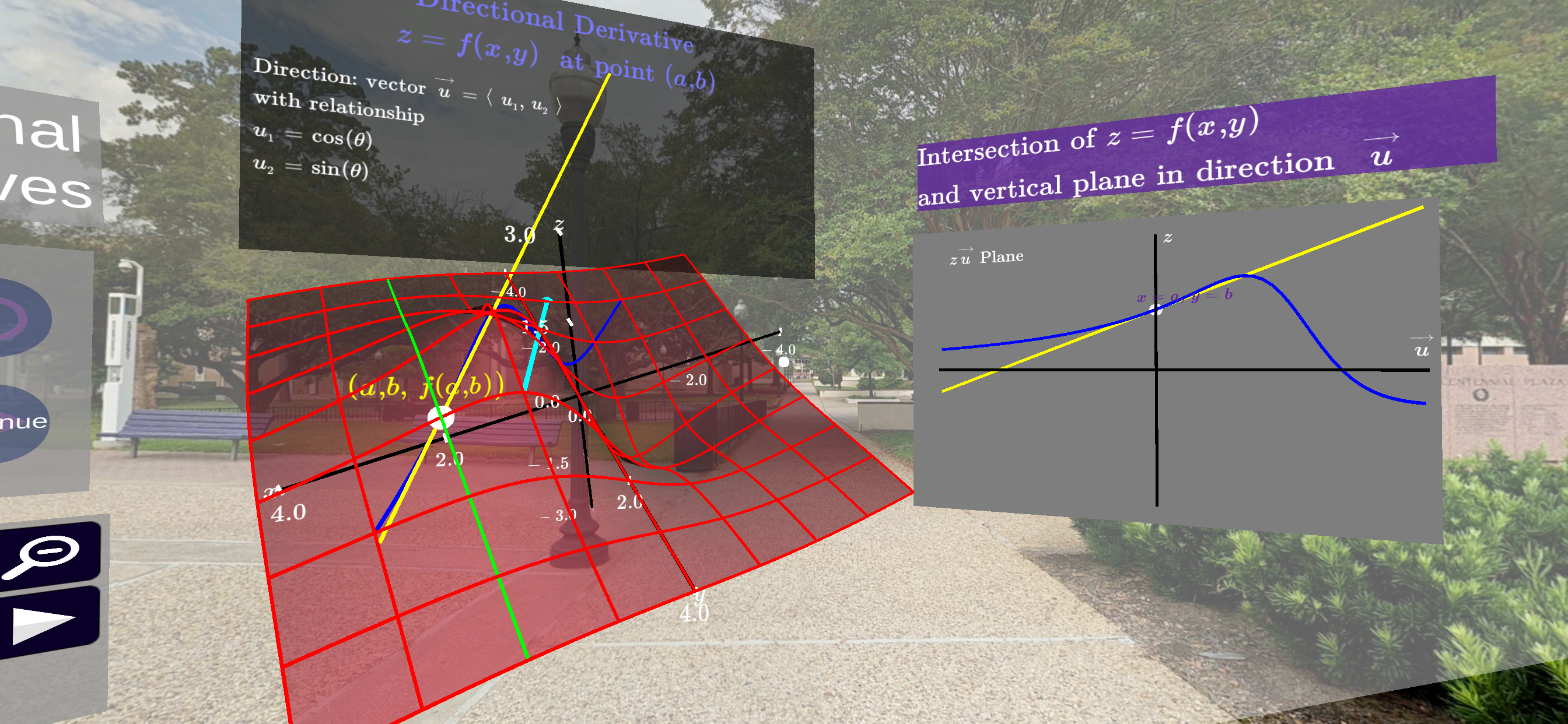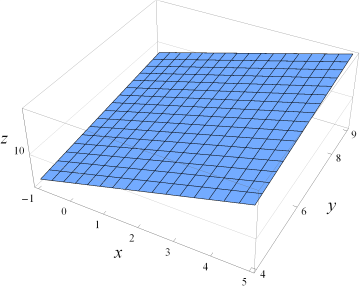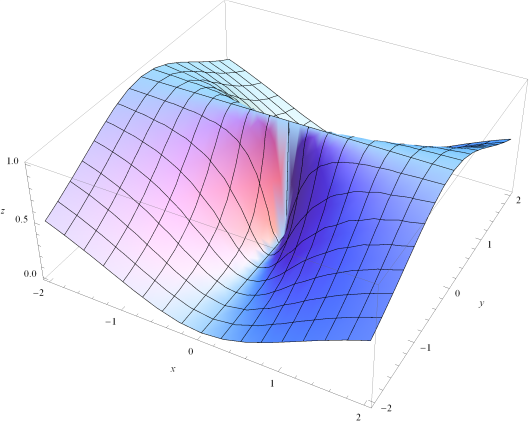Consider the example of the multivariable function
\begin{equation}
f(x,y) = x^2/4 - y^2/9\text{.}\tag{6.7.1}
\end{equation}
First let’s find the directional derivative at \((2,3)\) in the direction of \(\mathbf{v} = \langle -1, -2 \rangle \text{.}\) The partial derivative of \(f\) with respect to \(x\) and \(y\) are simple enough to compute
\begin{equation*}
f_x(x,y) = \frac{x}{2} \qquad \text{and} \quad f_y(x,y) = -\frac{2y}{9}\text{.}
\end{equation*}
We can consolidate these into the gradient
\begin{equation*}
\nabla f(x,y) = \langle \tfrac{x}{2}, -\tfrac{2y}{9} \rangle \text{.}
\end{equation*}
At the point \((2,3)\) we have
\begin{equation*}
\nabla f(2,3) = \langle 1, -\tfrac{2}{3} \rangle\text{.}
\end{equation*}
From
Section 6.5 we know how to interpret these values. If we are standing on the curve at
\((2,3, f(2,3))=(2,3,0)\) and walking in the positive
\(x\) direction our rate of elevation change would be 1 (i.e. 1 unit up). Likewise if we ventured to the positive direction our rate of change is
\(2/3\) units down. That is, 2 units down (-2) for every 3 units traveled in the positive
\(y\) direction.
The direction we desire to travel towards given by \(\mathbf{v} = \langle -1, -2 \rangle \text{.}\) Of course, this has both a magnitude (which we don’t need) and a direction. We isolate the direction by forming the vector
\begin{equation*}
\mathbf{u} =\frac{\mathbf{v}}{\Vert \mathbf{v} \Vert}= \langle \tfrac{-1}{\sqrt{5}}, \tfrac{-2}{\sqrt{5}} \rangle \text{.}
\end{equation*}
So, as we learned the directional derivative is the rate of change in the direction \(\mathbf{u}\) and is given by
\begin{equation*}
\nabla f(2,3) \cdot \mathbf{u} = \langle 1, -\tfrac{2}{3} \rangle \cdot \langle \tfrac{-1}{\sqrt{5}}, \tfrac{-2}{\sqrt{5}} \rangle = \frac{-1}{3\sqrt{5}} \text{.}
\end{equation*}
Thus if we are standing on the function at \((2,3,0)\) and start to walk in the direction \(\mathbf{u}\text{,}\) our rate of elevation change would be \(\frac{-1}{3\sqrt{5}}\text{.}\) The fact that this quantity is negative tells us we would be moving down. This is confirmed by the plot below.
Let’s take another approach. Referring back to
Subsection 6.4.1 we should be able to find this path on the function that passes through the point
\((2,3,0)\) and travels in the direction
\(\mathbf{v} = \langle -1,-2 \rangle \text{.}\) We start with two dimensional line
\begin{equation*}
x(t) = -t +2 \qquad y(t) = 2t +3
\end{equation*}
giving us the direction we want to travel. We can then overlay this on the curve by letting
\begin{equation*}
z(t) = f(x(t),y(t)) = \frac{x(t)^2}{4} - \frac{y(t)^2}{9} = \frac{(-t+2)^2}{4} - \frac{((2t+3)^2}{9}
\end{equation*}
in \(\mathbf{r}(t) = \langle x(t), y(t), z(t) \rangle\text{.}\) The last part turns into \(z(t) = 2 - \tfrac{1}{3}t + \tfrac{25}{36}t^2\text{,}\) which you should check. (We’ll wait.)
This parametric equation has a derivative, which we learned about in
Section 5.2. The derivative at of this path is given by
\(\mathbf{r}\'(t) = \langle -1,-2, -\tfrac{1}{3} + \tfrac{25}{18}t \rangle\text{.}\) At
\(t=0\) (the value at which the path
\(\mathbf{r}\) passes through
\((2,3,0)\)), we have
\(\mathbf{r}\'(0) = \langle -1,-2, -\tfrac{1}{3} \rangle \text{.}\)
Notice we have the directional derivative
\begin{equation*}
\nabla f(2,3)= \frac{-1}{3\sqrt{5}} \text{.}
\end{equation*}
and the derivative \(\mathbf{r}\'(0)\) given by
\begin{equation*}
\mathbf{r}\'(0) = \langle -1,-2, -\tfrac{1}{3} \rangle \text{.}
\end{equation*}
At first glance it appears these two do not really have anything in common; but, let us break things down further. We have interpreted the directional derivative earlier. We now do the same for \(\mathbf{r}\'(0)\text{.}\) This vector tells us that at \(t=0\) our rate of change on the curve is \(\langle -1,-2, -\tfrac{1}{3} \rangle\text{.}\) Note the first two coordinates correspond to the direction we want to travel, \(\mathbf{v}\text{.}\) In fact, we can look at a unit step in this direction by dividing by the magnitude of \(\mathbf{v}\text{.}\) \ Performing this action we get the vector
\begin{equation*}
\langle \tfrac{-1}{\sqrt{5}}, \tfrac{-2}{\sqrt{5}}, \frac{-1}{3\sqrt{5}} \rangle\text{.}
\end{equation*}
Now the interpretation and connection are clear, taking a 1 unit step in the \(\mathbf{v}\) direction our rate of change in elevation (\(z\)) is \(\frac{-1}{3\sqrt{5}}\text{,}\) which is precisely what we noted previously.
You can explore the function and the partial with respect to \(x\) using the tool below.






